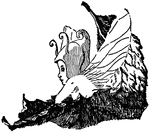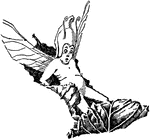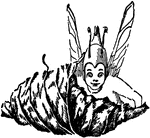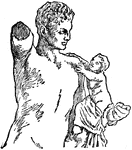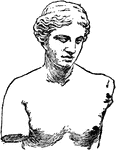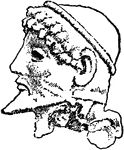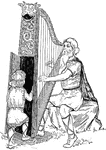
Aslog and Heimir
In Norse mythology, Aslog, daughter of Siegfried and Brunhild, becomes an orphan and is adopted by an…

Lombard Woman
In Norse mythology, there is a war between the Winilers and the Vandals. Odin takes the side of the…
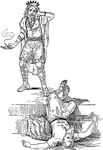
Olaf and Nornagesta
In Norse mythology, Nornagesta was fated by the three Norns: Urd, Verdandi, and Skuld. Urd and Verdandi…
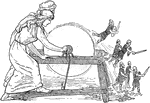
Frodi's Grindstone
In Norse mythology, Frey's son Frodi is given a magic grindstone from the fairies and elves. One who…
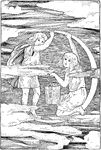
Children in the Moon
In Norse mythology, Mani drives the moon chariot at night. He finds a boy and a girl carrying a pail…
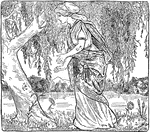
Frigga Asking a Tree
In Norse mythology, Frigga's son, Baldur the sun god, has a dream that he will die. Frigga travels the…
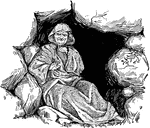
Loki as an Old Woman
In Norse mythology, Baldur is killed by an arrow wrapped with mistletoe (Baldur's only weakness), which…
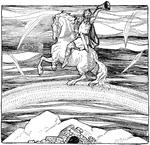
Heimdall Warns the Gods
In Norse mythology, Heimdall is the guardian of the gods. When Loki causes evil spirit to be in everyone,…
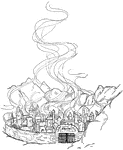
Surtur's Fire in the Golden City
In Norse mythology, Ragnarok is the final battle of good and evil. During this battle, Surtur the flame…
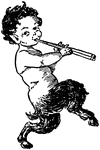
Pan
Pan in Greek religion and mythology, is the companion of the nymphs, god of shepherds and flocks, of…
Fairy Sitting Near Tree Banner
A pictorial banner illustrating an elf sitting near a tree, an owl in a tree branch, and moon in the…
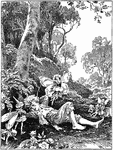
Fairy Tickling Boy Sleeping in Woods
An illustration of a fairy tickling a young boy sleeping in the forest underneath a tree.
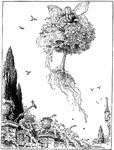
Fairy & Child in Flying Tree
An illustration of a fairy and a young girl sitting in a tree and is uprooted and flying in the air.
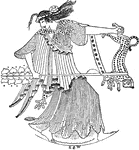
Maenads
In Greek mythology, Maenads were the female followers of Dionysus, the most significant members of the…
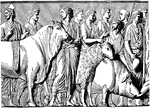
Suovetaurilia
The suovetaurilia was a sacred Roman sacrifice of a pig, a ram, and a bull to Mars, the god of war to…
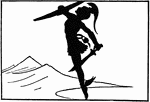
Perseus
Perseus, the legendary founder of Mycenae and of the Perseid dynasty there, was the first of the mythic…

Noise Making Siren
A siren is a loud noise maker. The original version would yield sounds under water, suggesting a link…
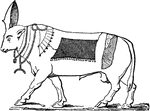
The Bull Apis
Also known as Hapis. In mythology, Apis was a commonly worshipped bull-deity in the Memphis region.
Column from the Temple of Denderah, with Hathor Masks, Time of Cesar
Column located in the Temple of Denderah, with masks of Hathor, an Egyptian sky goddess of love and…

Procession of Bel
"The god Bel is generally known by his Greek name Belus. But the attributes given him by the Greek authors…

Nana, The Phoenician Astarte
An image of the divinity whom the Phoenicians worshipped as Astarte, or the goddess associated with…
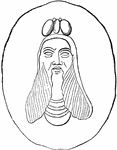
Image of Beelzebub, the Fly God
Literally means 'Lord of the Flies.' In Christian and Biblical texts, he is associated with a demon.

Colossus at Rhodes
Statue of the Greek god Helios. It is currently considered to be one of the Seven Wonders of the Ancient…

Temple of Neptune
"Paestum, the Greek Poseidonia, was a colony of Sybaris. The malarial atmosphere of the place led to…
Combat Between Achilles and Hector
A depiction of the mythological combat between Achilles and Hector.

Group of Gods and Goddesses
"The chief gods, in striking contrast with the monstrous divinities of the Oriental mythologies, had…
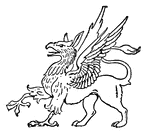
Griffin
In heraldry, the griffin is a fabulous animal, with the head and forefeet of an eagle, and the body,…

Dieties
A coin engraved with images of Minerva and Jupiter. Minerva was the Roman equivalent to the Greek goddess…

The Acropolis of Athens - Restoration of the Propylaea
Illustration of the Acropolis restored to what it may have looked like when originally completed. The…
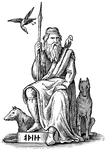
Woden or Odin, Germanic and Norse God, Seated with His Wolves and Crows
Illustration of the god called Woden in Germanic mythology and Odin in Norse mythology. Much like Zeus…

Thor Wielding Mjölnir, Standing on a Cloud
The Norse god Thor flings his hammer, Mjölnir, over his head. He is standing on a cloud and his name…
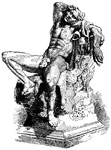
The Barberini Faun, or Drunken Satyr
Illustration of the life-size marble statue located in Munich, Germany. It was found in 1620 in a moat…

Silenus - Marble Sculpture
"In Greek mythology, a divinity of Asiatic origin, the foster-father of Bacchus, and leader of the satyrs,…
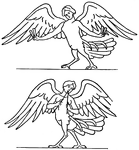
Sirens on a Greek Funeral Marble
"In Greek mythology, one of two, or three, or an indeterminate number of sea-nymphs who by their singing…
![Drawing of the Diana of Versailles, a 2nd-century Roman version in the Greek tradition of iconography. In Roman mythology, Diana ([djana]) was the goddess of the hunt, the moon and childbirth, being associated with wild animals and woodland, and having the power to talk to and control animals.](https://etc.usf.edu/clipart/188200/188203/188203-diana-of-versailles_mth.gif)
Diana of Versailles
Drawing of the Diana of Versailles, a 2nd-century Roman version in the Greek tradition of iconography.…

Sphinx of Lanuvium
A Graeco-Roman marble table support in the shape of a sphinx. It was found in the ruins of the Villa…
